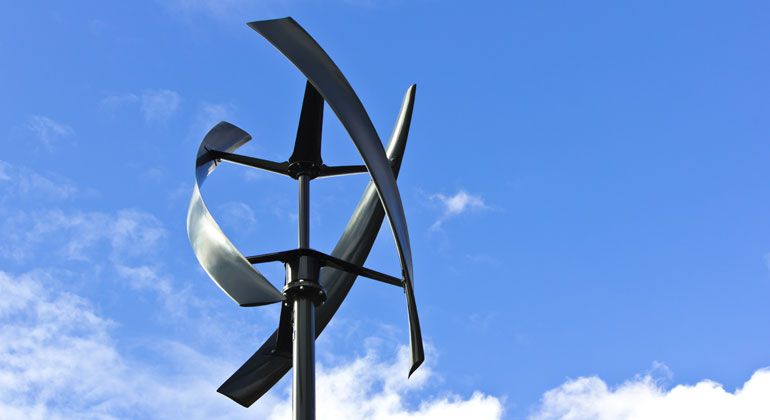A breath of fresh air for vertical wind turbines
To enable more wind turbines to be built in Switzerland, scientists are optimising vertical models that are more compact and quieter than conventional alternatives.
One of the major challenges of Switzerland’s energy transition is the reduced electricity production from solar power plants and dams in winter. Wind turbines, which double their output in the winter months, could play a key role in the transition to renewables. However, they take up a lot of space and are noisy. This makes it difficult to find suitable new sites for them, especially in Switzerland, with its high urban density and often steep or protected uninhabited areas.

Karen Mulleners, who received an assistant professorship for energy research funded by the Swiss National Science Foundation (SNSF), is working with her team on an alternative solution for increasing installed wind power capacity. The EPFL researcher is interested in wind turbines with a vertical axis of rotation, whose blades are perpendicular to the ground and rotate around the tower like a carousel, a shape that has earned them the name H-type wind turbines. Thanks to this difference in structure, they take up three times less space for the same blade length than their horizontal “classic” counterparts. They are also three times quieter and less dangerous to birds because of their slower and more predictable rotation. They therefore lend themselves both to increasing the density of existing wind farms and to installations closer to urbanised areas.
However, one physical challenge has so far slowed down their development: dynamic stall. This phenomenon can occur when the wind encounters an obstacle. Depending on the trajectories and speeds involved, vortices form behind the object to be bypassed, resulting in a turbulent air stream. In the case of wind turbines, dynamic stall occurs if the angle between the wind and the blade becomes too great. Classic wind turbines do not have this problem, since their blades rotate in the axis of the wind. The blades of vertical wind turbines, on the other hand, are particularly affected by this phenomenon. Because their axis of rotation is at a right angle to the wind, the angle between the wind and the blades varies continuously. As soon as the wind reaches a certain speed, they become prone to stalling. In a study published in the journal Nature Communications (*), the Lausanne team shows how this problem can be solved.
A complex miniature installation
Karen Mulleners’ goal is to limit the dynamic stall suffered by these wind turbines by enabling the blades to change their orientation or pitch angle. The idea is to install motors that rotate the blades partially about their own axis during their overall rotation around the axis of the wind turbine. “A boat needs a crew that adjusts the sails to keep it on course. By equipping wind turbine blades with small engines, we are giving them a captain so that they can also adapt to the conditions,” explains Sébastien Le Fouest, first author of the study.
The scientists still had to figure out how to adjust the blade’s pitch to achieve optimum performance. Many laboratories use computer simulations for these kinds of problems. This is far from an ideal solution, as the flows generated around an H-type wind turbine are difficult to predict and model. The Lausanne-based group therefore created a miniature single-blade wind turbine in a wind tunnel. Sensors were then installed to measure the energy produced.
In addition, the forces that the different components experience and the trajectories of the air particles during the tests are computed. This special installation makes it possible to rapidly test and understand the impact of different “wind turbine dances”, as Sébastien Le Fouest likes to call them, depending on the wind conditions. “In one minute, I get measurements that would take three weeks to obtain from a simulation,” says the researcher, who does not regret having spent nearly three years developing the device. “These kinds of experimental optimisations may seem simple, but they are the result of exceptional collective commitment,” Karen Mulleners adds.
Triple the efficiency
Once the system had been developed, the Lausanne-based team tested thousands of conditions using a “genetic algorithm”, which applies a logic of natural selection to the parameters tested. This method selects the settings that result in an optimum compromise between the greatest electrical efficiency and preservation of the wind turbine structure. As a result, the scientists were able to triple the efficiency of the laboratory’s wind turbine. To translate these figures to an industrial scale, the presence of several blades and the change in size must be taken into account. “Our data show that it is very likely that both the lifespan and the efficiency of classic wind turbines could be equalled or exceeded,” says Sébastien Le Fouest. The researcher hopes to make this idea a reality thanks to a BRIDGE grant from the SNSF and Innosuisse, which he received in October 2023. And with a collaboration to test the results on an industrial prototype already underway with a company in Switzerland, this project truly has the wind in its sails.








